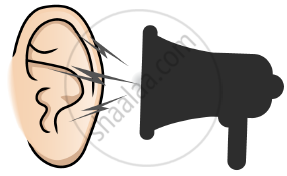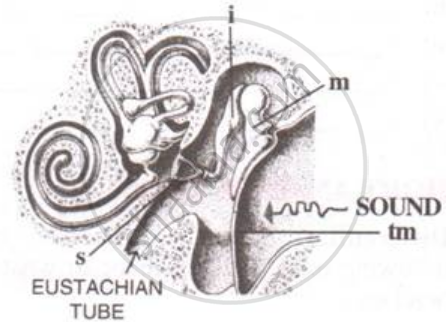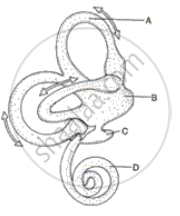Advertisements
Advertisements
प्रश्न
Given below is the diagram of the human ear. Study the same and answer the questions that follow:

(i) Give the biological term for the part labeled ‘A’ and state its function.
(ii) Name the part labeled ‘B’ and state its function.
(iii) Name the part labeled ‘C’ and state its function.
(iv) Give the function of ear wax.
उत्तर
(i) Ear Ossicles (Malleus, incus, and stapes)—To receive, magnify and transmit the sound vibrations to the membrane of the oval window.
(ii) Eustachian tube—It equalizes the air pressure on either side of the eardrum allowing it to vibrate freely.
(iii) Auditory Nerve—It transmits the impulses from cochlea to the brain.
(iv) Ear wax-has insect repellent properties hence prevent the entry of insects in the auditory canal. It also checks to die entry of dust particles in the ear. Thus, it lubricates and protects the eardrum.
APPEARS IN
संबंधित प्रश्न
Write short notes on the following: Cochlea
Answer the following:
Which part of the ear determines the pitch of a sound?
Given below is a representation of a kind of pollution. Study the same and answer the questions that follow

(i) Name the kind of pollution.
(ii) List any three common sources of this pollution.
(iii) Mention three harmful effects of this pollution on human health.
(iv) Explain the term ‘Pollutant’.
(v) Name two soil pollutants
Given in the box below are a set of 14 biological terms. Of these, 12 can be paired into 6 matching pairs. Out of the six pairs, one has been done for you as an example.
Example : endosmosis - Turgid cell.
Identify the remaining five matching pairs :
| Cushing’s syndrome, Turgid cell, Iris, Free of rod and cone cells, Colour of eyes, Hypoglycemia, Active transport, Acrosome, Addison’s disease, Blind spot, Hyperglycemia, Spermatozoa, Endosmosis, Clotting of blood. |
Name the following:
The part which equalises the air pressure in the middle and external ear.
Name the following:
The nerves which transmit impulse from ear to the brain.
Note the relationship between the first two words and suggest the suitable word for the fourth place.
sound : ear drum :: Dynamic balance : ……
Where is the Cochlea located? Briefly mention its function.
The figure below is the sectional view of a part of the skull showing s sense organ:

Name the sense organ.
There are three small bones in the muddle ear – anvil, hammer and stirrup :
(a) Which of these bones is in touch with ear-drum ?
(b) Which of these bones is in touch with oval window ?
Why should we not put a pin or pencil in our ears ?
The diagram alongside represents the structure found in the inner ear. Study the same and then answer the questions that follow:
(i) Name the parts labelled A, B, C and D.
(ii) Name the parts of the ear responsible for transmitting impulses to the brain.
(iii) Name the part labelled above which is responsible for:
1. Static equilibrium. 2. Dynamic equilibrium. 3. Hearing
(iv) Name the audio receptor cells which pick up vibrations.
(v) Name the fluid present in the inner ear.

Choose the correct answer :
Organ of corti is found in ___________
Differentiate between:
Cochlea and Concha.
Draw a labeled diagram of the inner ear. Name the part of the inner ear that is responsible for static balance in human beings.
Mention, if the following statement is True or False
Deafness is caused due to the rupturing of the pinna.
Select the CORRECT match of part of the human ear and its function.
The Eardrum moves inward when a rarefaction reaches it.
Choose the odd one out from the following terms and name the category to which the others belong:
- Draw a neat and well labelled diagram of the membranous labyrinth found in the inner ear.
- Based on the diagram drawn above in (i), give a suitable term for each of the following descriptions:
- The structure responsible for hearing.
- The sensory cells that help in hearing.
- The membrane-covered opening that connects the middle ear to inner ear.
- The nerves that carry impulses from the ear to the brain.
- The tube which equalises the air pressure on either side of the ear drum.
